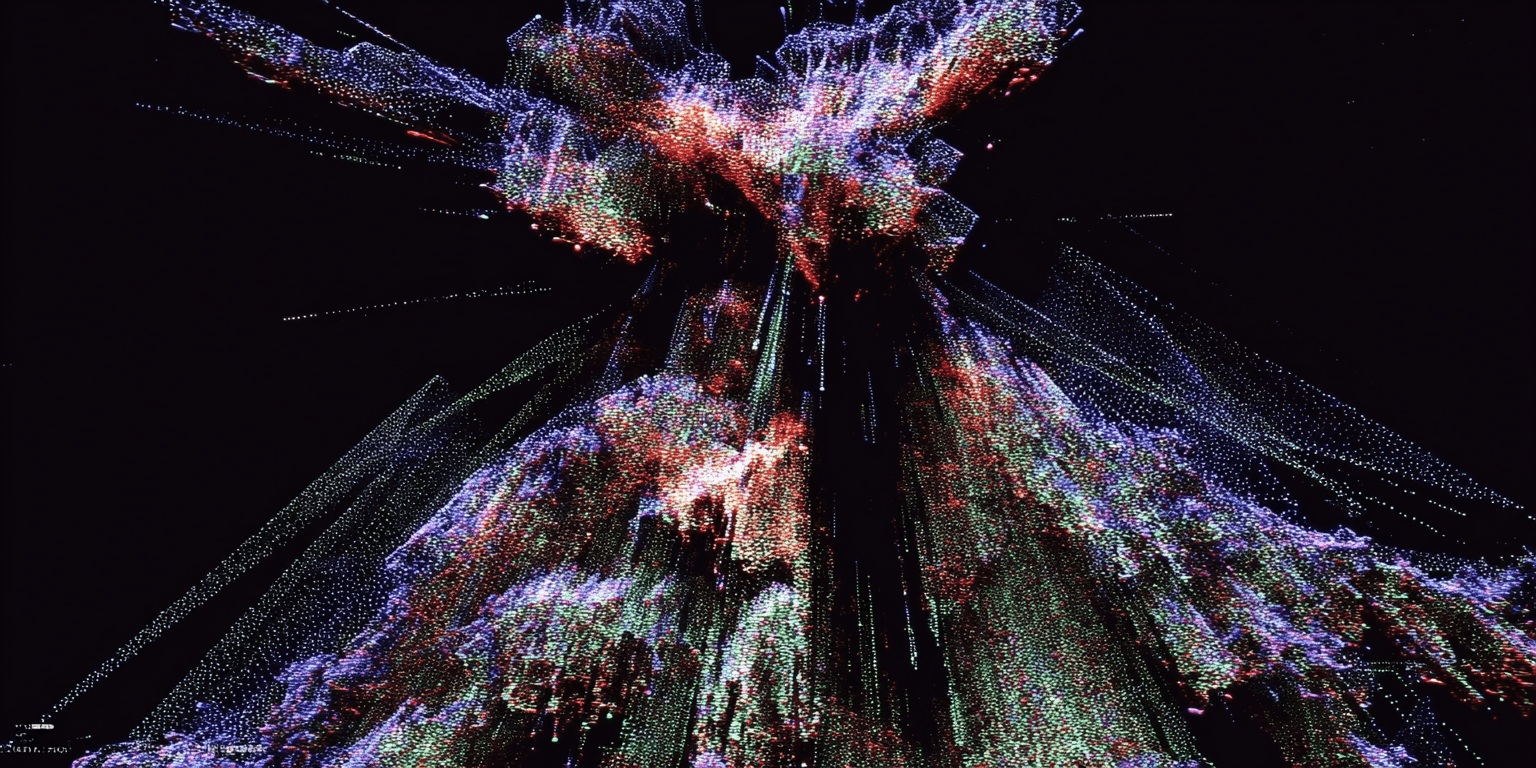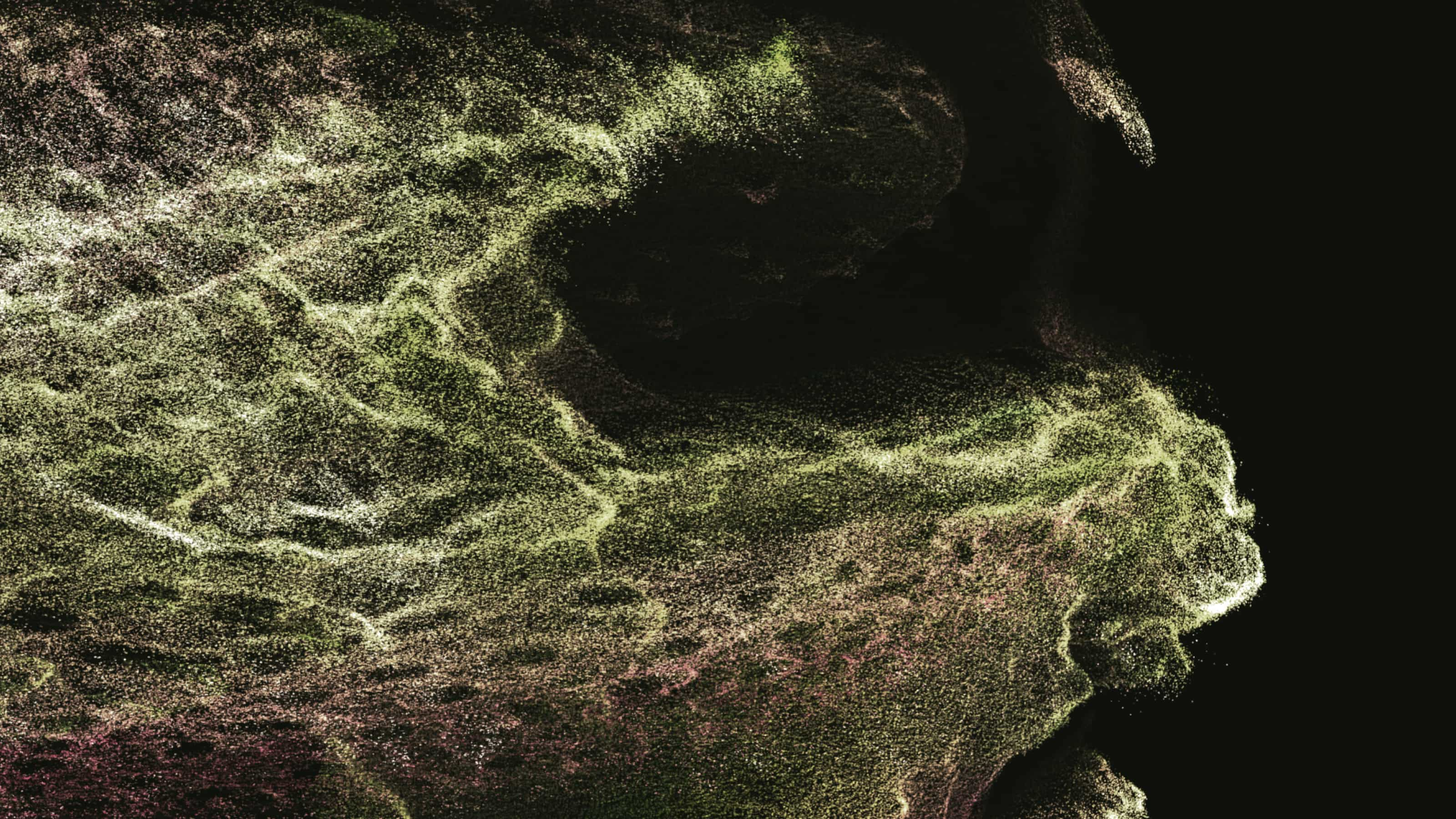
BioAgent Launchpad: Creating Schelling Points for Generative Bio
Introduction
AI is fundamentally reshaping how we work, build, and solve complex problems across industries. Autonomous agents have already made their presence felt in coding, amplifying the productivity of software engineering teams. However, science continues to be the domain demanding both the greatest potential and the largest needs of AI applications. Early progress in science for AI is quite promising, with agents poised to play a large role in catalyzing the era of autonomous science.
Yet at Bio, taking the tools of decentralized science and blockchain, we see a clear need to add to what the web2 agentic science world is creating. We can improve how agents lead to scientific progress by empowering BioAgents to be accessible, curated, funded, and above-all useful for researchers.
With the Launchpad, Bio makes it easy for agents to use additional onchain features: knowledge graphs, ownership tokens, smart contract interactions, and token payments in order to bring them into a real knowledge economy. Both the researchers interacting with the agents, and the agent’s token holders, stand to benefit from knowledge growth and appreciation of the agent’s contribution to scientific understanding.
BioAgents create schelling points for collective scientific intelligence. Each agent maintains an ever-growing knowledge graph that improves with every interaction. When researchers engage in productive conversations, they can contribute their insights back to the graph, preventing others from traversing the same exploratory paths unnecessarily. This compounds human curiosity and AI capability into accelerating discovery, with each agent’s token holders becoming permanent stakeholders in the expanding knowledge tree.
Cambrian Explosion in Web2 AI-for-Science
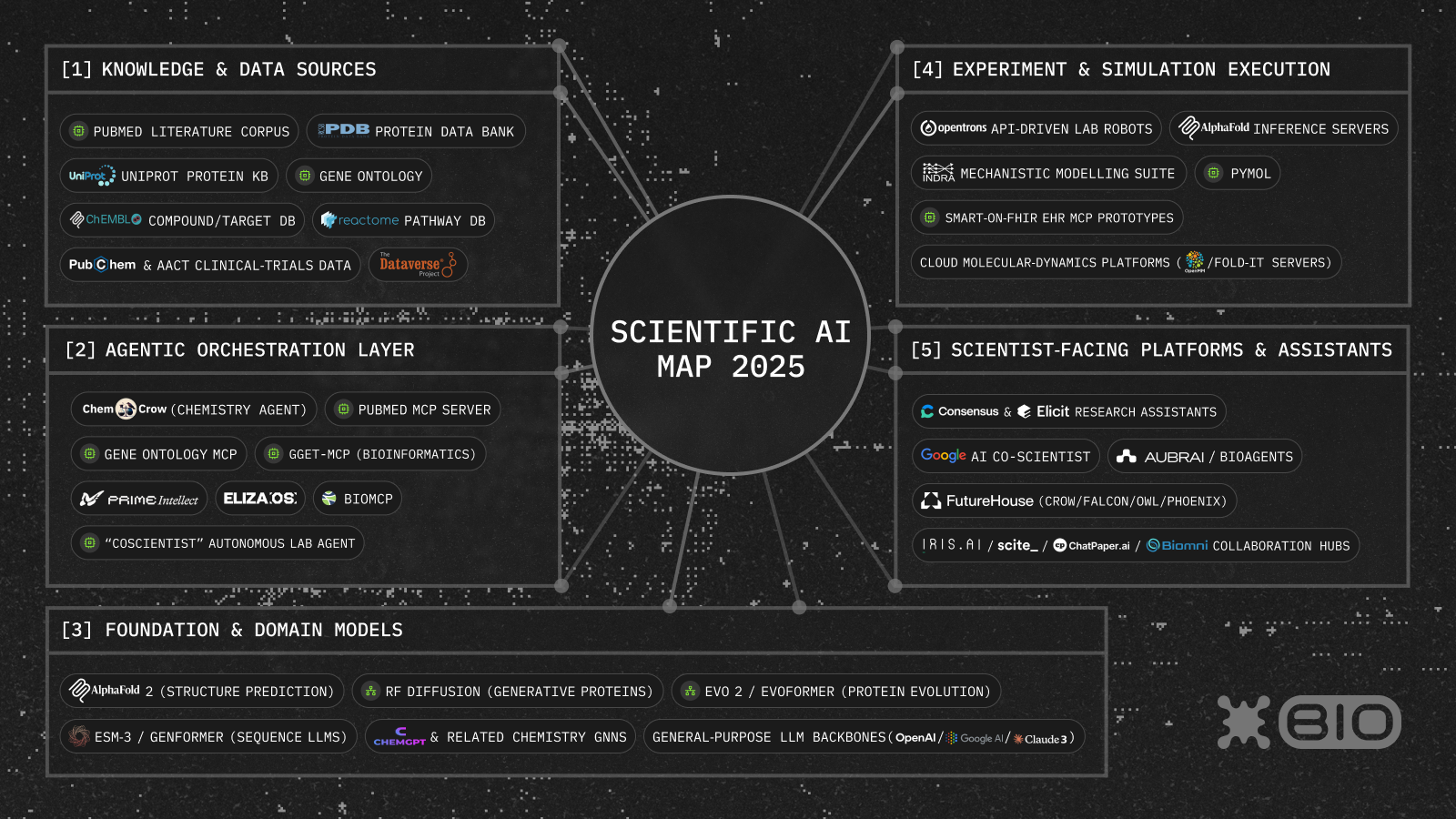
A common phrase in web2 for this idea is AI-for-science, or generative biology, and the field is experiencing incredible growth with nearly every academic lab and pharma company creating open-source tools on the spectrum between proofs-of-concept and published agent frameworks.
Leading institutions are building increasingly sophisticated scientific assistants:
Research Assistants & Literature Tools:
- Biomni (Stanford University) - A general-purpose biomedical agent that retrieves literature, mines databases, plans analyses and protocols, and executes code-based workflows from a chat interface
- AI Co-Scientist (Google Research) - Gemini-2-based multi-agent system that brainstorms novel hypotheses, ranks and refines them, and returns experiment plans through conversational prompts
- FutureHouse Platform - Suite of chat agents including Crow, Falcon, Owl, and Phoenix for high-precision literature Q&A, systematic reviews, and chemistry experiment design—benchmarked to outperform human experts
- Elicit (Ought) - Searches 100M+ papers, screens and extracts results, and auto-builds evidence tables for rapid literature reviews
- Scite Assistant - Answers research questions with "Smart Citations," showing supporting or contrasting evidence for transparent reasoning
- Knowledgie - Fact-based Q&A over 200M+ papers with source verification
- Undermind - Autonomous agent that reads thousands of papers and delivers fully-referenced insight reports
Specialized Scientific Models:
- Ether0 (FutureHouse) - A 24-billion-parameter chemistry LLM excelling at proposing drug-like molecules from natural language prompts
- Evo 2 (Arc Institute) - A 40B+ parameter genomic foundation model trained on 9.3 trillion nucleotides, capable of identifying disease mutations and generating million-base DNA sequences
- Geneformer (HuggingFace) - Transformer model pretrained on ~100 million single-cell transcriptomes for predicting gene expression changes
- AlphaFold 2 (DeepMind) - The breakthrough protein structure prediction system
- RFdiffusion (Baker Lab) - Diffusion model for generating novel protein structures in seconds
These tools remain siloed within traditional Web2 infrastructure. They can't coordinate, transact, or build shared knowledge graphs decentrally. This is where BioAgents fundamentally differ.
Modular Technical Architecture

The ElizaOS v2 Foundation: Our agents use modular architecture that orchestrates multiple knowledge sources and tools:
- Plugin SQL Database - Stores operational data including messages, conversations, and sessions
- Dual Knowledge Systems:
- Plugin DKG (Decentralized Knowledge Graph) - Integrates scientific papers, hypotheses, citations, and biological terms using Blazegraph or Oxigraph triple stores
- RAG Plugin - Handles private knowledge including unpublished papers, emails, and research notes through vector PostgreSQL databases
- People conversing with the agents, sharing SMILES codes, uploading research papers, and proposing ideas for refinement, all are actively participate in an evolving knowledge ecosystem where every interaction strengthens the collective understanding.
- Intelligent Runtime - Orchestrates components, manages conversations and memories, and plans plugin/tool calls
- Real-time Server - Manages WebSocket and RESTful API routes for seamless communication
The Network Effect of Scientific Discovery
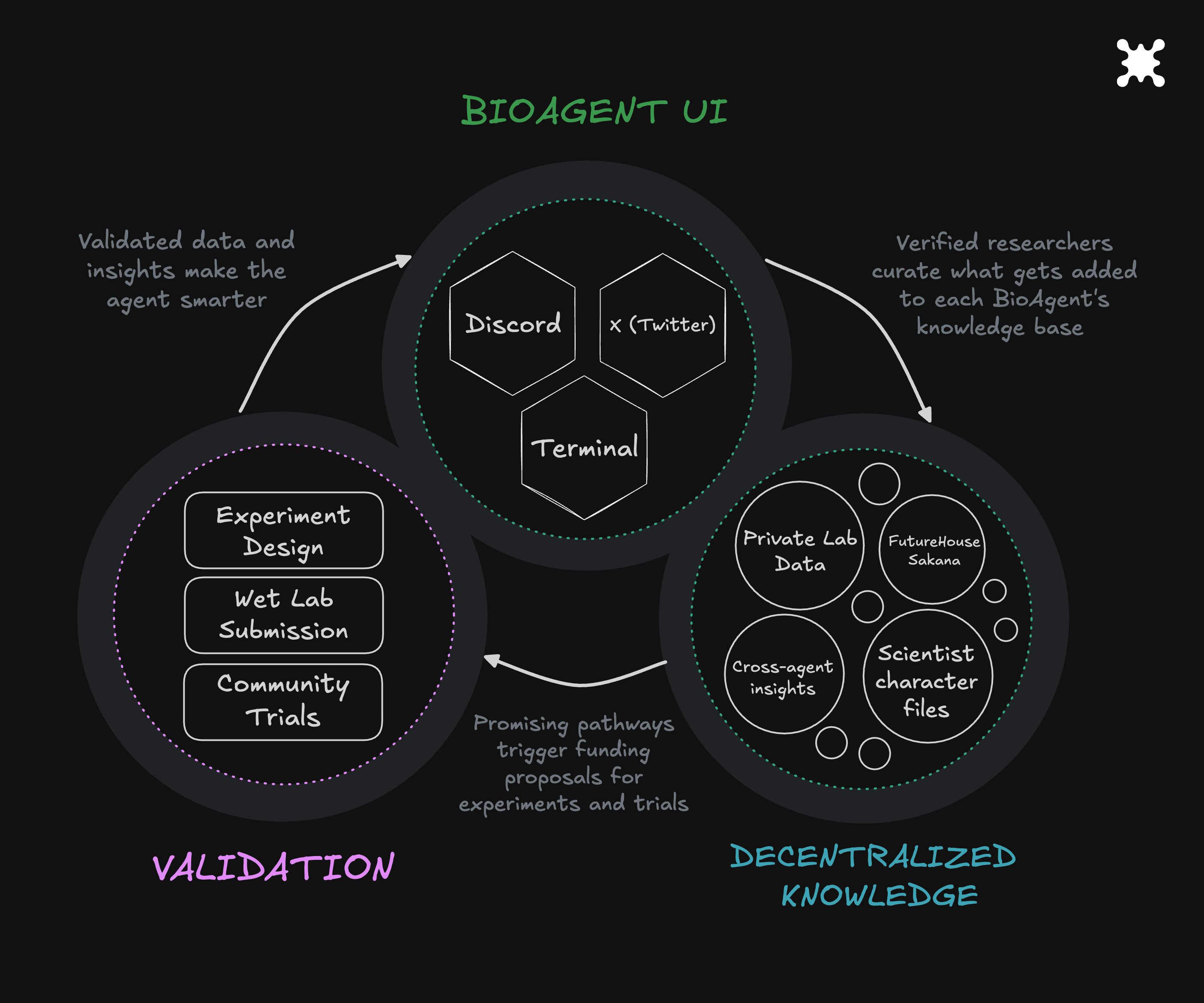
Each BioAgent creates a unique gravitational pull in science. Researchers interacting with agents contribute to an evolving knowledge ecosystem. When a productive dialogue yields insights, users can:
- Enhance the Knowledge Graph - Add their discoveries directly to the agent's knowledge base, creating a breadcrumb trail for future researchers
- Initiate BioDAO Discussions - Send conversation summaries to relevant Discord channels, sparking micro-proposal discussions that can evolve into funded research
- Execute Real Experiments - Submit compound testing requests to pump.science with experiment fees in SOL, bridging the gap between AI-generated hypotheses and wet-lab validation
This accelerates discovery: AI generates hypotheses at superhuman speed, humans validate them, and successful paths encode into collective memory. The result: a self-improving system where each interaction adds value.
Automated Deployment Pipeline
The launchpad features a sophisticated 7-phase deployment workflow that transforms agent configurations into live, monitored services:
Phase 1: Configuration Submission
- Users submit agent specifications through an intuitive web interface
- System validates inputs and generates unique Agent IDs
- Configuration stored securely with queued deployment status
Phase 2: Asynchronous Processing
- Real-time status updates keep users informed
- Background services orchestrate the build pipeline
Phase 3: Build Process
- Automated generation of Dockerfiles, environment configurations, and startup scripts
- Creation of containerized agent packages uploaded to secure registries
Phase 4: Kubernetes Deployment
- Automated K8s manifest generation and application
- Intelligent orchestration ensures reliable cloud deployment
Phase 5: Monitoring Setup
- Prometheus-based health tracking configuration
- Automated alert systems for proactive issue detection
Phase 6: Completion & Notification
- Users receive deployment confirmation with live agent URLs
- Full integration with Discord, Twitter/X, and custom interfaces
Phase 7: Ongoing Monitoring
- Continuous health checks and performance metrics
- Real-time status dashboards for agent operators
Scalable Multi-Agent Infrastructure
Creating new agents requires minimal effort through our character file system, and they are backed by a powerful memory system to enable agents to grow with the researcher they chat with over time.
With long-term state and preference recall, each interaction becomes sharper and more personalized. Scientists enjoy agents that remember preferences, provide proactive planning, and deliver smart reminders automatically.
Character Configuration:
- System prompts defining persona and expertise
- Biography and conversation style
- Plugin selection (DKG, RAG, FutureHouse)
- Knowledge graph access permissions
- Voice descriptions and interaction templates
Teams launching agents simply provide:
- Google Drive links containing papers in JSON-LD format
- Private documents for RAG enhancement
- Character specifications and branding elements
Our BioAgents v1 repository converts PDFs to knowledge graph format automatically, while continuous updates can be managed through dedicated BioMiner agents that constantly enrich the shared scientific memory.
Built on the battle-tested ElizaOS framework, BioAgents demonstrate how decentralized AI can accelerate scientific discovery while creating sustainable economic models for research.
Each agent features:
- Privacy-First Architecture - User-uploaded documents remain private, enhancing only their agent experience
- Wallet-Based Authentication - Privy integration enables secure Web3 login
- Citation Transparency - All knowledge sources displayed with metadata while protecting private RAG citations
- Multi-Modal Interaction - Text and voice inputs with streaming responses
Ownership in the Knowledge Stream
Each agent’s token holders co-own the agent’s knowledge stream and benefit from its discoveries. As the knowledge tree branches and grows at AI-accelerated speeds, certain paths will lead to breakthrough moments: IP sales, retroactive public goods funding, or commercial applications. When these "lightning strikes" occur, value flows back through the knowledge tree to all dependent nodes, rewarding contributors who helped build this collective intelligence.
In the first phase of BioAgents, we’re rolling out a permissioned approach for BioDAOs in our network to experiment with agent creation. DAOs can upload papers to distributed knowledge graphs, train agents on lab notes and private data, and explore integrations—all while maintaining data sovereignty through our secure infrastructure.
Onchain Scientific Actions of BioAgents
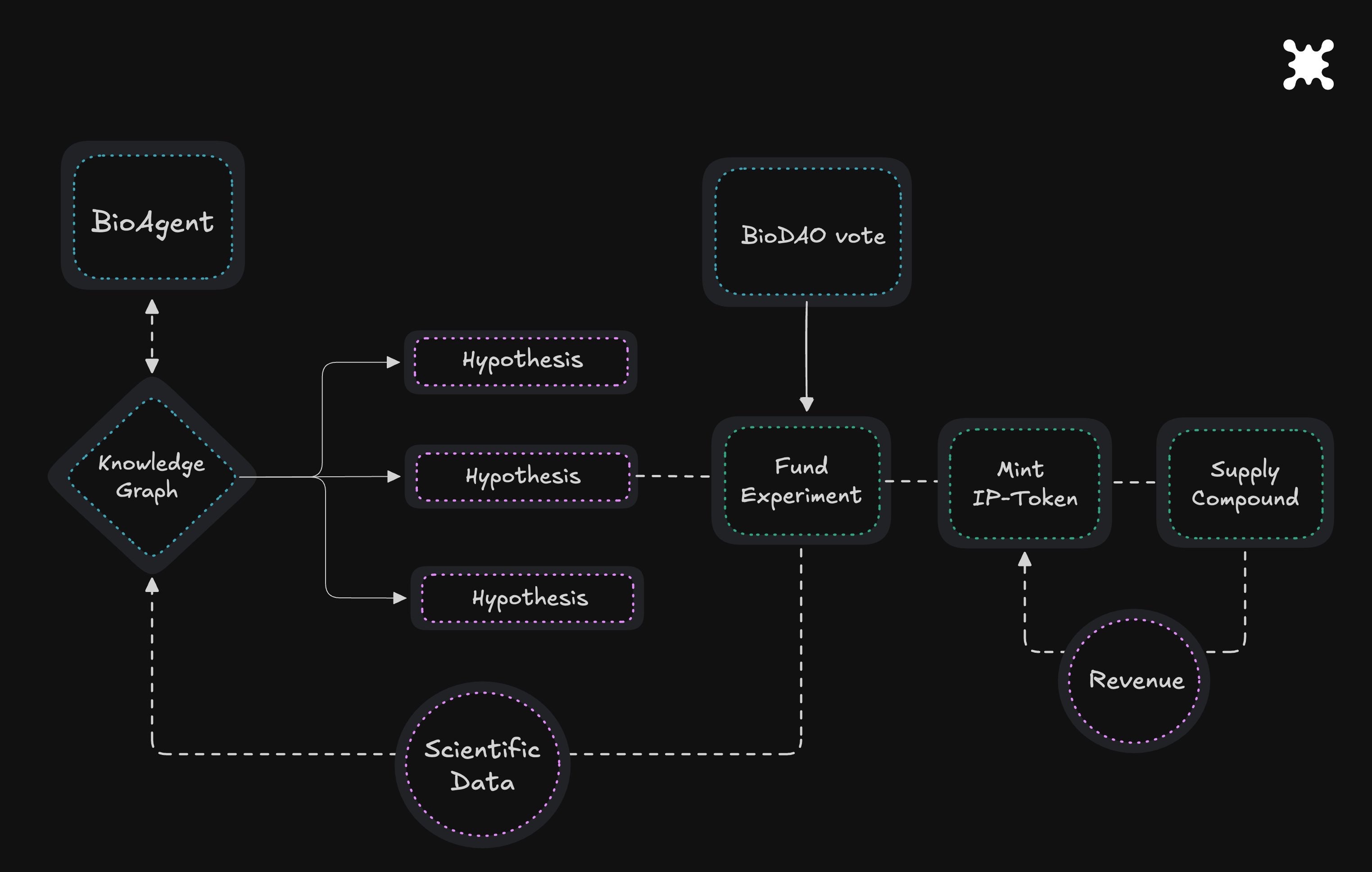
BioAgents take meaningful onchain actions that advance scientific discovery through smart contracts:
- One-Click Proof of Idea (PoI) Creation: Agents automatically generate and submit Proofs of Idea directly from chat conversations, creating an immutable record of scientific hypotheses and discoveries on-chain through seamless UI integration.
- Base Attestation Integration: Scientific claims and experimental results can be attested on Base with a single command, building a verifiable chain of scientific progress that connects research outputs to blockchain verification.
- Direct BioDAO Funding Proposals: When agents identify promising research directions, they can submit funding proposals directly to relevant BioDAO Discord channels (requires token threshold balance), streamlining the path from idea to funded research through automated Discord plugin interactions.
- Pump.Science Integration: Breaking the barrier between digital hypothesis and physical validation, agents can submit compound testing requests directly to pump.science laboratories. Researchers simply approve the SOL transaction, and their AI-generated hypothesis enters the real-world experimental queue.
- Automated Literature Mining and Knowledge Graph Updates: Every interaction enriches the shared knowledge graph through SPARQL queries and updates, with agents continuously discovering connections between papers, identifying research gaps, and proposing novel hypotheses stored in decentralized triple stores.
- Cross-Agent Collaboration: Multiple BioAgents can coordinate through shared knowledge infrastructure, with each agent maintaining its own repository while contributing to collective scientific understanding.
Technical Integration Features
Platform Plugins:
- Twitter/X Integration - Autonomous posting, timeline monitoring, and engagement with configurable intervals and advanced scoring algorithms
- Discord Integration - Full server management, voice channels, slash commands, and channel-specific restrictions
- FutureHouse Plugin - General science assistance, research support, and experiment design capabilities
Infrastructure Components:
- Container Registry for agent software packages
- Kubernetes orchestration for scalable deployments
- Prometheus monitoring with automated health checks
- RESTful APIs and WebSocket connections for real-time interaction
These onchain capabilities, combined with our robust technical infrastructure, transform AI from a passive assistant into an active participant in the scientific process. Researchers holding $BIO tokens gain access to an expanding ecosystem of scientific agents, with usage creating deflationary pressure through token burns.
Conclusion: The Future is Collaborative Intelligence
The future of scientific research demands a fundamental reimagining of how knowledge is created, shared, and incentivized.
BioAgents represent the convergence of autonomous scientific intelligence, blockchain transparency, and community-driven innovation to create a true knowledge economy.
With each agent token, we're creating ownership stakes in an exponentially expanding network of scientific intelligence that compounds human curiosity with AI capability. This isn't merely launching a cryptocurrency—we're establishing permanent stakeholder positions in a growing knowledge tree where breakthroughs benefit everyone who contributed to the discovery path. When significant value is realized through IP sales or public goods funding, rewards flow through the knowledge graph to recognize all contributors who helped build the foundation for success.
BioAgents create schelling points for collective scientific intelligence, where sophisticated privacy-preserving architecture keeps researchers in control while enabling unprecedented collaboration. Each productive conversation feeds back into the knowledge graph, ensuring that exploratory paths are shared rather than repeatedly traversed, accelerating the pace of discovery across disciplines.
This is our vision: a decentralized scientific ecosystem where every curious mind can contribute to and benefit from collective progress. Where AI agents work tirelessly to connect insights across fields, and where successful discoveries create cascading rewards throughout the entire network. The Cambrian explosion of agentic science, and with BioAgents, we're building the onchain infrastructure for generative biology to power the next decade of science.





